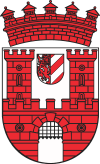Czerwieńsk
| Czerwieńsk | |||
|---|---|---|---|
|
Neo-Gothic church | |||
| |||
 Czerwieńsk | |||
| Coordinates: 52°0′56″N 15°24′18″E / 52.01556°N 15.40500°E | |||
| Country |
| ||
| Voivodeship | Lubusz | ||
| County | Zielona Góra | ||
| Gmina | Czerwieńsk | ||
| Area | |||
| • Total | 9.22 km2 (3.56 sq mi) | ||
| Population (2006) | |||
| • Total | 4,138 | ||
| • Density | 450/km2 (1,200/sq mi) | ||
| Postal code | 66-016 | ||
| Climate | Cfb | ||
| Website | http://www.czerwiensk.pl | ||
Czerwieńsk [ˈt͡ʂɛrvʲɛɲsk] (German: Rothenburg an der Oder) is a town in Zielona Góra County, Lubusz Voivodeship, Poland, with 4,152 inhabitants (2005). Czerwieńsk is a railroad junction, where the Wrocław - Zielona Góra - Szczecin connection meets the line to Poznań. It was formerly a part of Germany until the end of World War II.
History
Around 1550 the von Rothenburg family from "Nettkowe" (Nietków ) built a small hunting manor some 5 kilometres from their ancestral home.[1] Soon a small village arose around the manor,[1] known as Neu Netkau - "New Netkau". The settlement was part of the region of Brandenburg's Neumark and lay directly at the border with Silesia. While conveniently located at the crossing of important trading routes, the village's growth was halted by the devastating Thirty Years' War.[1] In 1654 a Lutheran church was built there. It served both local residents and the Protestant inhabitants of the nearby city of Grünberg (Zielona Góra), then part of domain of Roman Catholic Habsburgs.[1] The first priest of the new church was Christoph Reiche.
On 24 January 1690 a new town of Rothenburg an der Oder ("Rothenburg on the Oder") was started right next to the village of Neu Netkau. The town received town rights from Frederick III, Elector of Brandenburg and grew rapidly in the 17th century, thanks to numerous draper shops founded there, mostly by Protestant refugees from Silesia.[1] In 1701 the town, as part of Brandenburg-Prussia, became part of the Kingdom of Prussia.[1] In 1707 priest Johannes Reiche, the descendant of Christoph Reiche, started the construction of a new, larger church. In 1736 Alexander Rudolf von Rothenburg was knighted by king Frederick William I of Prussia and received the title of a Count. His son, Friedrich Rudolf von Rothenburg, was among the closest friends of King Frederick the Great.
In 1788 the town was bought by Peter von Biron, the last Duke of Courland who owned also the nearby town of Sagan. The town became the dowry of his daughter Pauline, who married into the Swabian line of the Hohenzollerns. The family retained control of large parts of the town and its surrounding even after the abolition of feudal ownership in Prussia.
In 1811 the first city plan was prepared. The 1816 administration reform of Prussia officially detached the town from the Province of Brandenburg and attached it to the Province of Silesia. In mid-19th century another Protestant church was built not far from the city square by a Protestant dissenter Martin Gottfried Julius Schöne. In 1870 the town was connected to the Guben-Zbąszyń railway and a train station was constructed. In 1877 the old Protestant church was demolished and replaced with a new one, built in then-popular Gothic Revival style. In 1900 the town had 632 inhabitants. By 1908 the village of "Polnisch Nettkow" was incorporated into Rothenburg. The number of inhabitants grew and by 1933 reached 1430 people.
The city survived World War II relatively undamaged, but the manor was destroyed by the Red Army. In 1945, in the aftermath of the war, the town was annexed by Poland.[1] The German population of the area was expelled and replaced with Polish refugees from Greater Poland and areas annexed by the USSR (notably from Tarnopol and Monasterzyska).[1] Renamed initially to Rozborg and then to its modern name, the town was stripped of the city rights, which it received again in 1969.[1] Currently the population exceeds 4100 inhabitants.
References
Notes
Bibliography
- Przemysław Góralczyk. "Historia miasta". czerwiensk.pl (in Polish). Czerwieńsk: Urząd Gminy i Miasta w Czerwieńsku. Retrieved 2013-08-18.
Coordinates: 52°01′N 15°24′E / 52.017°N 15.400°E

